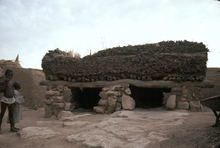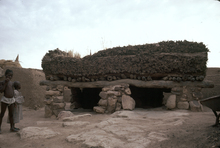Dogon Men's Meeting House
| dc.coverage.spatial | Site: Bandiagara (Mali) | en_US |
| dc.coverage.temporal | creation date: ca. 20th century | en_US |
| dc.creator | Unknown | en_US |
| dc.date | ca. 20th century | en_US |
| dc.date.accessioned | 2013-01-10T18:35:11Z | |
| dc.date.available | 2013-01-10T18:35:11Z | |
| dc.date.issued | 1900-1981 | en_US |
| dc.identifier | 173968 | en_US |
| dc.identifier.uri | http://hdl.handle.net/1721.3/89361 | |
| dc.description | "The togu na is a basic element in the Dogon village, not just a physical building but as an associated reference point to the whole village. The togu na is a meeting place, a place for teaching and working, for rest and conversation. The considerable modifications in the type of togu na as well as in the close relationship of the building with the outside, correspond largely to the three areas of the Dogon land: the highland area, the rocky belt, and the plain. Only the roof remains unchangeable as far as its material is concerned and the way it is built which suggests a ritual involving the whole community." [Spini T. and S., 1977: Togu Na. The African Dogon House of Men, House of Words. Rizzoli International Publications]. | en_US |
| dc.description | exterior, June 1981 | en_US |
| dc.format.medium | mud | en_US |
| dc.format.medium | wood (plant material) | en_US |
| dc.relation.ispartof | 142853 | en_US |
| dc.rights | (c) 1981 Mark Horton | en_US |
| dc.subject | Vernacular architecture | en_US |
| dc.subject | Meeting houses | en_US |
| dc.subject | Architecture--Africa | en_US |
| dc.subject | Dogon (African people) | en_US |
| dc.title | Dogon Men's Meeting House | en_US |
| dc.title.alternative | Dogan Togu na | en_US |
| dc.type | Image | en_US |
| dc.rights.access | All rights reserved | en_US |
| dc.identifier.vendorcode | 27-28 | en_US |
| vra.culturalContext | Malian | en_US |
| vra.technique | construction | en_US |
| vra.worktype | Meeting house (religious building) | en_US |
| dc.contributor.display | Malian | en_US |
Files in this item
This item appears in the following Collection(s)
-
Aga Khan Visual Archive
Images of architecture, urbanism, and the built environment in the Islamic world



